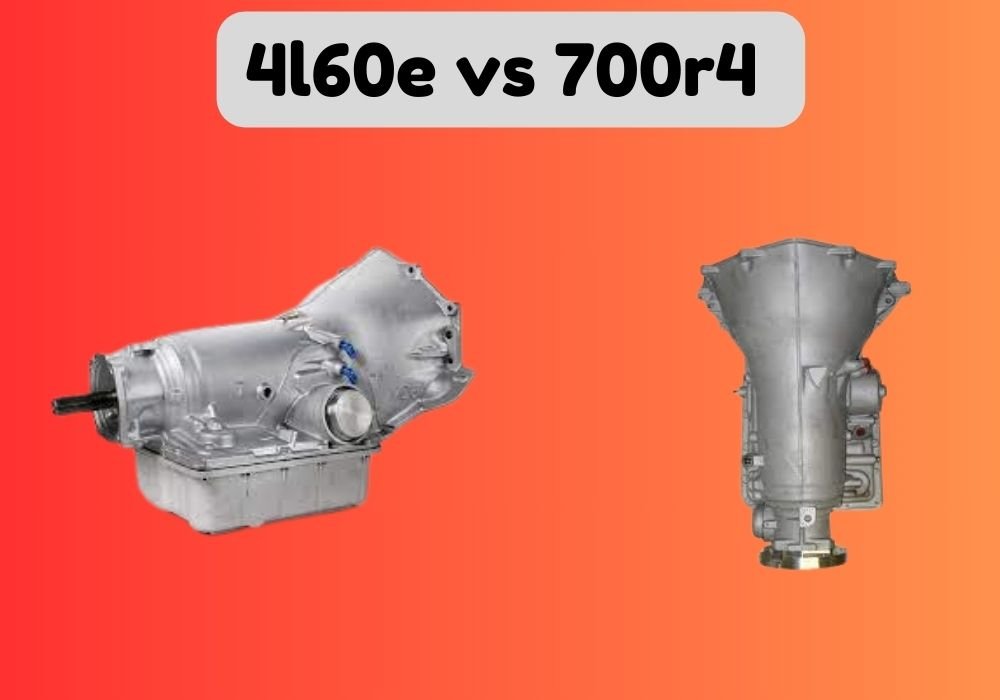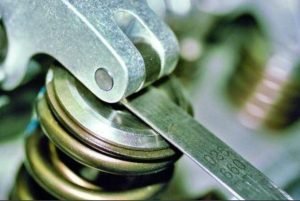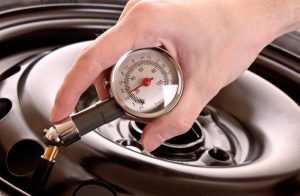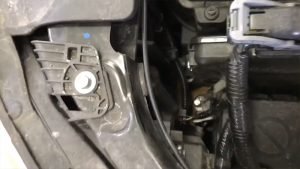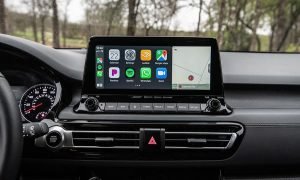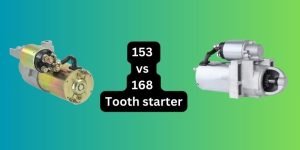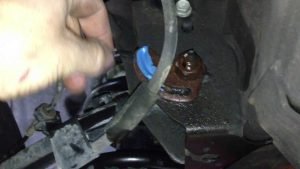Automatic transmissions play a crucial role in automobiles, silently ensuring that our vehicles shift gears seamlessly and efficiently as we navigate the roads. While most drivers may need to consider the intricacies of their vehicle’s Transmission, choosing the right one can significantly impact your driving experience, performance, and even maintenance costs.
This blog post will investigate automatic transmissions, comparing two popular models: the 4L60E and the 700R4. These transmissions have unique features, advantages, and disadvantages, making them suitable for different vehicles and driving scenarios.
Before we dive into the specifics of each Transmission, let’s explore why the choice of an automatic transmission matters and why understanding the differences between the 4L60E and 700R4 is essential for any automotive enthusiast or owner. Whether you’re looking to upgrade your existing Transmission or are simply curious about these two iconic models, this comparison will help you make an informed decision for your vehicle.
Contents
The 4L60E Transmission:
The 4L60E, often hailed as a successor to the earlier 700R4, has become a staple in modern automatic transmissions. Let’s look closer at this Transmission, understanding its history, key features, and pros and cons.
Overview and History:
The 4L60E is part of the Turbo-Hydramatic series of transmissions produced by General Motors. It was introduced in the early 1990s, primarily as an evolution of the 700R4, with several design improvements to enhance performance, reliability, and efficiency. Over the years, it has been widely used in various GM vehicles and has gained popularity among automotive enthusiasts for its versatility.
Key Features and Specifications:
- Four-Speed Automatic: As the name suggests, the 4L60E is a four-speed automatic transmission. It offers a range of gear ratios, allowing for smooth acceleration and efficient highway cruising.
- Electronic Control: Unlike its predecessor, the 700R4, the 4L60E features electronic control. This means that its shifting patterns and timing are managed by an onboard computer, resulting in more precise and adaptive gear changes.
- Overdrive Gear: The 4L60E is equipped with an overdrive gear, which reduces engine RPM at highway speeds, improving fuel efficiency and reducing wear and tear.
- Lockup Torque Converter: This Transmission is designed with a lockup torque converter, which further enhances fuel efficiency by reducing slippage in the converter during cruising.
Pros and Cons:
Pros:
- Smooth Shifting: The electronic control of the 4L60E ensures smoother and more precise gear changes, enhancing overall driving comfort.
- Improved Fuel Efficiency: The overdrive gear and lockup torque converter contribute to better fuel economy, particularly on long highway drives.
- Widely Available: Due to its widespread use in GM vehicles, replacement parts, and knowledgeable mechanics are readily available.
Cons:
- Not Ideal for Heavy Loads: While suitable for most passenger vehicles, there may be better choices than the 4L60E for heavy-duty applications or towing.
- Limited to GM Vehicles: It is primarily found in GM vehicles, determining its compatibility with other brands.
- Potential Reliability Issues: Some early models of the 4L60E had reliability concerns, but later versions and aftermarket improvements have addressed many of these issues.
Understanding the 4L60E’s features and characteristics is essential when deciding whether it’s the right Transmission for your vehicle. In the next section, we’ll explore its predecessor, the 700R4, and compare the two to help you make an informed choice.
The 700R4 Transmission:
Before we delve into the comparison between the 700R4 and the 4L60E, it’s crucial to understand the 700R4 Transmission itself. This Transmission has its unique history, features, and advantages, which we’ll explore in this section.
Overview and History:
The 700R4, also known as the 4L60 (without the “E” for electronic), is an automatic transmission developed by General Motors. It was introduced in the early 1980s and marked a significant advancement in automated transmission technology. The 700R4 was designed to replace the older Turbo 350 and Turbo 400 transmissions, offering improved fuel efficiency and performance.
Key Features and Specifications:
- Four-Speed Automatic: Similar to the 4L60E, the 700R4 is a four-speed automatic transmission, providing a range of gear ratios for various driving conditions.
- Mechanical Control: Unlike the electronically controlled 4L60E, the 700R4 relies on mechanical and hydraulic systems to manage gear shifting. This can be advantageous for those who prefer a simpler, non-computerized transmission.
- Overdrive Gear: The 700R4 is equipped with an overdrive gear, which reduces engine RPM at highway speeds, contributing to improved fuel economy.
- Lockup Torque Converter: Like the 4L60E, the 700R4 features a lockup torque converter to reduce slippage and enhance fuel efficiency during cruising.
Pros and Cons:
Pros:
- Mechanical Simplicity: The 700R4’s mechanical control system may appeal to those who prefer a transmission without electronic components, potentially reducing repair complexity.
- Overdrive and Fuel Efficiency: Including an overdrive gear and lockup torque converter improves highway fuel economy, making it a good choice for long-distance driving.
- Aftermarket Support: The 700R4 has been in use for many years, and as a result, a wide range of aftermarket parts and upgrades are available for enthusiasts looking to enhance performance.
Cons:
- Less Precise Shifting: The mechanical control system can produce less precise and adaptive shifting than electronic transmissions like the 4L60E.
- Compatibility: While the 700R4 was used in various GM vehicles, it may be less readily available or compatible with specific newer models compared to the 4L60E.
- Potential for Earlier Reliability Issues: Early models of the 700R4 had some reliability concerns, although subsequent versions and aftermarket improvements have addressed many of these issues.
Now that we’ve explored the 700R4’s characteristics and features, it’s time to compare these two transmissions to help you determine which one best suits your needs and preferences. The next section’ll compare the 4L60E and the 700R4 head-to-head.
Head-to-Head Comparison: 4L60E vs. 700R4
To provide a clear and concise comparison between the 4L60E and the 700R4 transmissions, let’s break down their key attributes and characteristics in a table format:
| Aspect | 4L60E | 700R4 |
| Transmission Type | Electronic | Mechanical/Hydraulic |
| Number of Gears | 4-speed | 4-speed |
| Electronic Control | Yes | No |
| Overdrive Gear | Yes | Yes |
| Lockup Torque Converter | Yes | Yes |
| Smooth Shifting | Precise electronic control | May be less precise |
| Fuel Efficiency | Improved due to electronics | Good with overdrive gear |
| Aftermarket Support | Widely available | Extensive upgrades available |
| Compatibility | Primarily GM vehicles | Primarily GM vehicles |
| Reliability | Improved over earlier models | Improved over earlier models |
Key Takeaways:
- Electronic Control: The 4L60E has precise electronic control, allowing for smoother and adaptive shifting, while the 700R4 relies on mechanical and hydraulic systems.
- Fuel Efficiency: Both transmissions offer improved fuel efficiency with their overdrive gears and lockup torque converters, making them suitable for highway driving.
- Aftermarket Support: Both transmissions have extensive aftermarket support, but the 700R4 has been in use for longer, resulting in a broader range of available upgrades.
- Compatibility: Both the 4L60E and 700R4 are primarily found in GM vehicles, so compatibility may be limited to GM or GM-based platforms.
- Reliability: Both transmissions have improved over earlier models, but proper maintenance is key to ensuring longevity and reliability.
Ultimately, the choice between the 4L60E and the 700R4 will depend on your specific vehicle, driving needs, and personal preferences. While the 4L60E offers modern electronic control and precise shifting, the 700R4 appeals to those who prefer mechanical simplicity and may benefit from its extensive aftermarket support. Consider your vehicle type, usage, and whether you value electronic control or mechanical reliability when deciding.
Which Transmission is Right for You?
Choosing between the 4L60E and the 700R4 requires careful consideration of various factors, including your vehicle type, driving habits, and personal preferences. Here, we’ll help you make an informed decision based on different scenarios:
Daily Driver and Fuel Efficiency:
If you primarily use your vehicle for daily commuting, long highway drives, or fuel efficiency is a top priority, the 4L60E may be the better choice. Its electronic control, precise shifting, and the overdrive gear and lockup torque converter contribute to smoother drives and improved fuel economy.
Classic or Vintage Vehicles:
The 700R4, with its mechanical and hydraulic control, might be the preferred option for classic or vintage cars where authenticity and simplicity are valued. It offers a vintage driving experience while still providing overdrive for highway cruising. The extensive aftermarket support for the 700R4 can also help enhance its performance and reliability.
Performance and Upgrades:
If you’re an automotive enthusiast looking to build a high-performance vehicle, both transmissions have their advantages. The 700R4, with its robust mechanical design and aftermarket upgrades, can handle increased power and torque. However, the 4L60E’s electronic control offers precise tuning for optimal performance, making it a great choice for modern high-performance builds.
Budget Considerations:
Budget plays a significant role in your choice. The 700R4 might be more cost-effective for initial installation and maintenance due to its mechanical simplicity. However, if you plan to upgrade or modify your Transmission extensively, the costs can add up, potentially negating the initial savings. The 4L60E, while initially more expensive, may offer better performance and fuel efficiency value.
Towing and Heavy-Duty Applications:
If you intend to use your vehicle for towing or heavy-duty applications, neither Transmission is ideal. Both are primarily designed for passenger vehicles and may need to handle the stress of heavy loads better. Consider a transmission engineered explicitly for towing and heavy-duty use in such cases.
Personal Preferences:
Lastly, personal preferences matter. Some drivers prefer the feel of mechanical control and the simplicity of the 700R4, while others appreciate the precise shifting and modern features of the 4L60E. Your comfort and satisfaction behind the wheel are essential factors to consider.
Upgrades and Modifications for the 4L60E and 700R4 Transmissions
Suppose you’ve chosen the 4L60E or the 700R4 Transmission and are looking to enhance their performance durability or customize them to your specific needs. In that case, there are a variety of upgrades and modifications available. Let’s explore some of the common aftermarket options for both transmissions:
Upgrades for the 4L60E:
- Shift Kit: Installing a shift kit can improve shift firmness, reduce slippage, and enhance overall performance. It’s a popular modification for those seeking crisper gear changes.
- Performance Torque Converter: Upgrading to a higher stall torque converter can improve acceleration and launch performance. This is particularly beneficial for high-performance or modified vehicles.
- Transmission Cooler: Adding an auxiliary transmission cooler helps maintain optimal operating temperatures, reducing the risk of overheating, especially when towing or under heavy load.
- Reprogramming: Aftermarket tuning software allows you to reprogram the Transmission’s electronic control unit (ECU). This enables customization of shift points, firmness, and other performance parameters to match your driving style.
- Performance Clutches and Bands: Replacing the stock clutches and bands with high-performance alternatives can enhance the Transmission’s ability to handle increased power and torque.
Modifications for the 700R4:
- TV Cable Adjustment: The 700R4 relies on a TV (throttle valve) cable for control. Proper adjustment of this cable is crucial for shift quality. Upgraded TV cable kits are available to ensure precise control.
- Performance Rebuild: If you’re looking for maximum performance, a complete transmission rebuild with high-performance components such as heavy-duty clutches, bands, and valve bodies can be undertaken.
- Gear Ratios: The gear ratios inside the Transmission can be changed for specific applications. This can involve swapping out planetary gear sets to achieve desired performance characteristics.
- External Cooler: Similar to the 4L60E, adding an external transmission cooler can help maintain optimal operating temperatures, especially when towing or in high-stress situations.
- Lockup Kit: A lockup kit can be installed to engage the torque converter lockup clutch in the overdrive gear for better fuel efficiency and reduced heat generation.
- Shift Improver Kit: Like the shift kit for the 4L60E, a shift improver kit can improve shift firmness and reduce slippage in the 700R4.
- TV Cable Corrector: A TV cable corrector kit can be used to ensure proper TV cable adjustment. This is especially useful when swapping the Transmission into a different vehicle.
Remember that when considering upgrades and modifications, it’s important to match the changes to your vehicle’s intended use and your specific goals. Consult with a qualified transmission specialist or mechanic with experience in these transmissions to ensure that the modifications are done correctly and are compatible with your vehicle’s setup.
Additionally, remember that regular maintenance, including fluid changes and inspections, is essential to ensure the longevity of your upgraded Transmission, regardless of whether it’s a 4L60E or a 700R4.
What are the main differences between 265 70r17 and 285 70r17 tires?
When it comes to differences between tire sizes, the main distinctions between 265 70r17 and 285 70r17 tires lie in their width and overall diameter. The 285 70r17 tires are wider and have a slightly larger diameter compared to the 265 70r17 tires, which can impact vehicle performance and handling.
Conclusion
Choosing between the 4L60E and the 700R4 is a significant decision for any vehicle owner or enthusiast. Each Transmission has its own set of characteristics, advantages, and limitations. Let’s recap the key points to consider when making your choice:
4L60E:
- Electronic Precision: The 4L60E offers precise and adaptive shifting thanks to its electronic control, resulting in a smoother driving experience.
- Fuel Efficiency: It excels in fuel efficiency, making it suitable for daily commuting and long highway drives.
- Modern Features: Electronic control, overdrive gear, and a lockup torque converter provide modern conveniences.
- Aftermarket Support: A wide range of aftermarket upgrades is available for performance enthusiasts.
- Compatibility: Primarily found in GM vehicles.
700R4:
- Mechanical Simplicity: The 700R4 appeals to those who prefer mechanical control and a simpler design.
- Overdrive Gear: It offers improved fuel efficiency with its overdrive gear.
- Aftermarket Upgrades: Extensive aftermarket support makes it a favourite among classic car enthusiasts and modifiers.
- Compatibility: Like the 4L60E, it is primarily found in GM vehicles.
In making your decision, consider the following factors:
- Vehicle Type: Think about the vehicle you own or plan to build. Does it require modern electronic control or can it benefit from the simplicity of mechanical operation?
- Driving Habits: Consider how you use your vehicle. Do you prioritize fuel efficiency, performance, or a balance of both?
- Budget: Evaluate your budget for the initial transmission choice and potential upgrades and modifications.
- Personal Preference: Your comfort and satisfaction behind the wheel are essential. Some drivers prefer the modern amenities of the 4L60E, while others appreciate the classic feel of the 700R4.
Ultimately, the choice between the 4L60E and the 700R4 depends on your specific needs and preferences. Both transmissions have proven themselves in various applications, and with the right upgrades and maintenance, they can provide years of reliable service.
Before making your decision, consult with automotive experts or mechanics with experience with these transmissions to ensure that your choice aligns with your vehicle’s purpose and long-term driving satisfaction. Whether you choose electronic precision or mechanical simplicity, both transmissions offer their unique charm and capabilities in the world of automatic transmissions.
Related FAQs:
What is the difference between a 4L60E and a 700R4 transmission?
- The primary difference is that the 4L60E is electronically controlled, while the 700R4 relies on mechanical and hydraulic systems for shifting. The 4L60E offers more precise and adaptive shifting, improved fuel efficiency, and modern features like overdrive and lockup torque converter.
Can I swap a 4L60E for a 700R4 or vice versa in my vehicle?
- Yes, it’s possible, but it may require modifications and adjustments. Compatibility with your vehicle’s engine, transmission mounts, and electronics must be considered. Consult with a transmission specialist for guidance.
Are there any reliability issues with these transmissions?
- Both the 4L60E and 700R4 have seen improvements over earlier models. Proper maintenance and, in some cases, aftermarket upgrades can enhance their reliability and longevity.
What kind of vehicles commonly use the 4L60E and 700R4 transmissions?
- Both transmissions are commonly found in General Motors (GM) vehicles, including various Chevrolet, GMC, Buick, and Cadillac models. They have been used in various applications, from trucks to sports cars.
Can I upgrade these transmissions for better performance?
- Yes, both the 4L60E and 700R4 can be upgraded for improved performance. Upgrades may include shift kits, performance torque converters, cooler installations, reprogramming, and even complete rebuilds with high-performance components, depending on your goals and budget.
Affiliate Disclosure: As an Amazon Associate, I earn from qualifying purchases made through links on this site.

